Pulsara Around the World - 2025 Recap and January 2026
December Recap After an incredibly busy events year with 102 conferences, trade shows, and sponsorships, December was on the slower side for us, with...
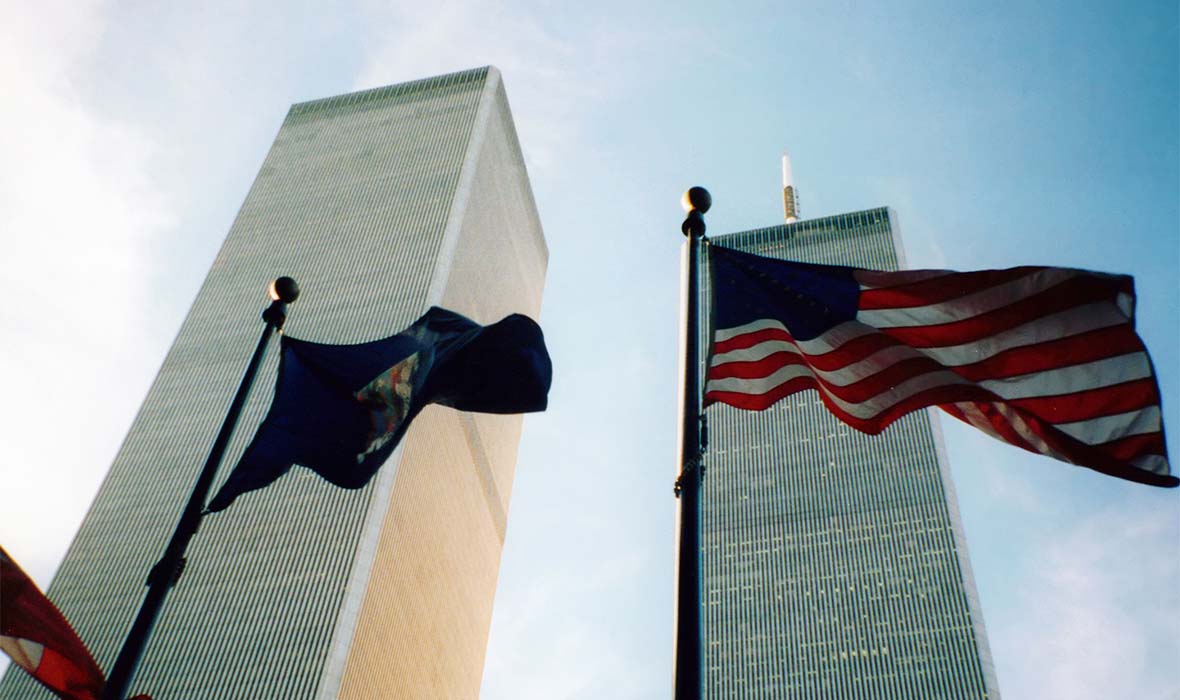
Editor’s Note: I recently had the privilege of spending time with Chief John Peruggia, retired Chief of FDNY EMS. He shared his vivid memories of September 11, 2001, and how the world has (and hasn’t) changed over the past 20 years. Chief, thank you for your time and sacrifice to the EMS community. \ Special thanks to Kinsie Clarkson (Pulsara's Product Marketing Specialist, 2020-2025) for writing today's blog post. You can connect with her on LinkedIn.
—
Where were you on September 11, 2001? Instantly, each of us can vividly remember what we were doing when two planes collided with the World Trade Center. The stories that came from that day continue to echo down through the years as we approach the 20th anniversary of the event.
But few people quite know the story like those who were there.
Chief John Peruggia was one of those people.
John began his career in EMS as an EMT in New York City in 1983. He then became a paramedic and continued to move up the ranks. In 1996, EMS merged with the fire department under a mayoral executive order and he was promoted to captain, and then shortly thereafter assigned to the Operations Bureau, where he served as an executive officer for planning.
In May of 2001—just 4 months before that tragic day—John Peruggia was promoted to Chief of Planning for both fire and EMS.
September 11th was his second day back on the job after a two-week vacation.
Chief Peruggia was on his way to work when he received a panicked call from headquarters.
“Where was I, where was I, a plane just hit the World Trade Center!”
At first, he thought his staffers were welcoming him back to work with a prank call.
“I thought they were messing with me, so I said yeah, okay, whatever, and I hung up the phone,” he said. “And then they called back and said ‘No, seriously, seriously.’ I said, ‘Well, it's probably a small plane; I’m about to get on the Verrazzano Bridge,’ which goes from Staten Island to Brooklyn, and I said, ‘I’ll see you guys in a little bit, just keep me up to date.’”
John turned on his lights and sirens, adjusted the radio, and continued his commute into the city. “A whole bunch of police and fire vehicles came racing by me, so I jumped in the convoy right behind them. And when we were mid-span on the Verrazzano Bridge, we had an amazingly clear line of sight of lower Manhattan, and I saw the tower with this tremendous plume of smoke coming out of the top. And at that point, I knew it wasn't a small plane that hit the tower.”
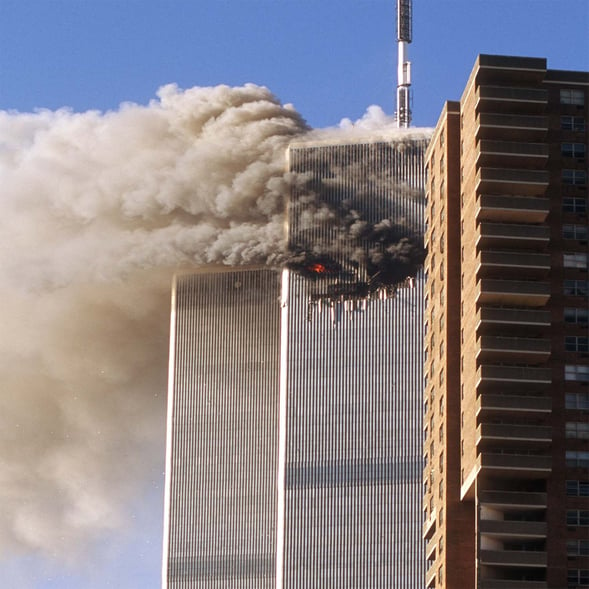
Chief Peruggia communicated with his teams and advised them to meet him at the Office of Emergency Management (OEM).
And then, he drove into a nightmare.
“I was on the Brooklyn-Queens Expressway, entering the Battery tunnel, which exits on West Street, about four or five blocks south of the World Trade Center. As I entered the tunnel, I could see the towers very clearly. There was all this paper and debris coming down. I saw the size of the hole and thought…this is going to be one hell of a long day.”
Peruggia stayed tuned to his radio and continued his response. “I was nearly three-fourths of the way or so through the tunnel when the report came on the radio that a second airliner had hit the World Trade Center. And at that point, it immediately flashed in my mind that this wasn't an accident; it was clearly some sort of a premeditated terrorist attack.”
Driving through the tunnel, he realized that the bridge might be the next target.
“I panicked, because I thought, ‘What if they blow up the tunnel?’ And I tell people this story and they laugh, because they think I’m joking, and it's no pun intended, but—exactly as I was thinking that, I saw the light at the end of the tunnel. For the exits. And I said, well I’m getting out of this tunnel!”
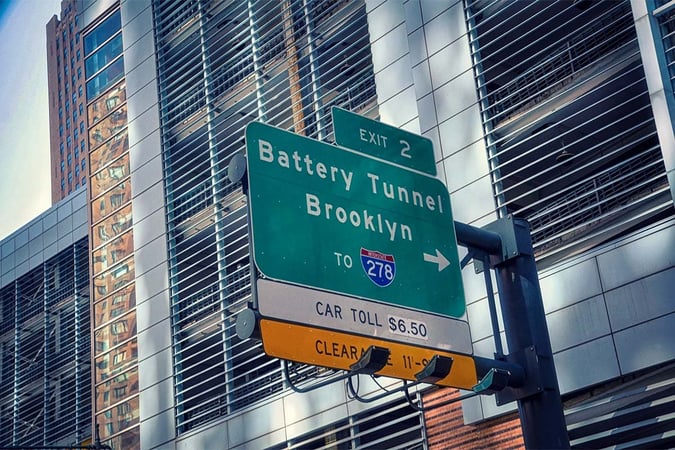
Safely out of the tunnel, Peruggia pulled his car up on the sidewalk about a half a block away, careful not to park too close to the scene. He put on his gear and started walking up West Street, making his way through what could only be described as a war zone.
“There was debris all over…body parts and bodies. As I got closer, I passed a group of firemen, and they said, ‘Hey, Chief, you might want to walk on the other side of the street. There's a lot of stuff falling down on this side.’ So I did, and I continued up to the World Financial Center, which was directly across the street from the North Tower. There I met up with Peter Ganci, who was the FDNY Chief of Department and my immediate boss, as the planning chief.
And I said, 'Hey Pete, I got some guys on it, and I’m on my way over there now. Is there anything that you need me to do?'
Pete put his arm around me. He looked up, and I looked up, and we saw these two massive buildings fully engulfed in flames, some 800, 900 feet above our heads.
And he said, ‘Peruggia?’ And I said, ‘Yes?’ He said, ‘We are not ever going to put these fires out today. All we can hope to do is rescue and save as many people as possible.’
I said, ‘I got it, I understand. It's going to be a real rough one.’
And he said, ‘Do me a favor.’ I said, ‘Sure, what's up?’ And he said, ‘Make sure your helmet is on and be careful walking around the corner to OEM. I don't want anything to happen to you.’
Here's the guy who was the chief of the fire department, with the biggest disaster in the world that he's responsible for managing and coordinating. And he's worried about me walking around the corner.”
Once Peruggia made it to 7 World Trade and the OEM offices, reports of another plane reached them. They began making plans to evacuate the building, relocate the command post and the OEM Coordination Center, and began moving injured people into a loading bay adjacent to the building.
As they were working, a new threat emerged: the possibility that the buildings would collapse.
“A number of us were inside discussing different strategies and needs and figured out what we would need to go on here, as well as waiting for some direction as to where we were going to move the command post. Some period of time passed by, and then this gentleman who identified himself as an engineer indicated that the buildings were in imminent danger of collapse. I tried to get the command post on the radio, but I couldn't get through. The radio was crazy. I tried on the cell phone, but there was no signal because everybody in the world was on their phones. So I took my other staff member, Richie, who's one of my best friends, and I said, ‘Listen, you’ve got to get to the command post. This is where it's at. Tell the chief that I’ve got some information that the buildings are in danger of collapse, maybe we should pull people out.’ So Richie took off. A short time later, the first building collapsed.”
Having been part of the response to the 1993 bombing of the World Trade Center, which caused a great deal of damage to the base of the building, Peruggia—like so many others—never expected that the tower might collapse.
But it did.
“I remember, I was in the lobby, and there was this awful sound. People describe it like a freight train or a roar—it's somewhere like that. And next thing you know, the lobby went black. And there was dirt, and all the glass facade came pounding in on all of us. People were getting hit with debris. I know my helmet got knocked off, my head had gotten cut. And everyone just laid there for a few minutes, and then we got up, and with the dust, you couldn't breathe.”
At first, Peruggia didn’t realize that the first building had collapsed. With reports of a third plane headed toward them, he naturally assumed that that had caused the explosion. They began evacuating everyone into the loading bay, and Peruggia ended up outside, directing people who were evacuating from the North Tower.
“One of the last people out of the building was this woman who clearly had a fractured wrist. I stopped her and I took her scarf off, and I made a little sling for her. I told her, ‘Now, just continue down along the building, and some firefighters will direct you to medical health—‘ and she was looking at me with this panicked, frightened stare. All of a sudden, she started screaming. And I’m like, ‘Ma’am, ma'am, it's okay,’ and it was like I was not even there to her. So I turned around. The dust had started to clear, and that's when I saw the outer skeleton of the South Tower, and no building. That's when I realized that the building came down.”
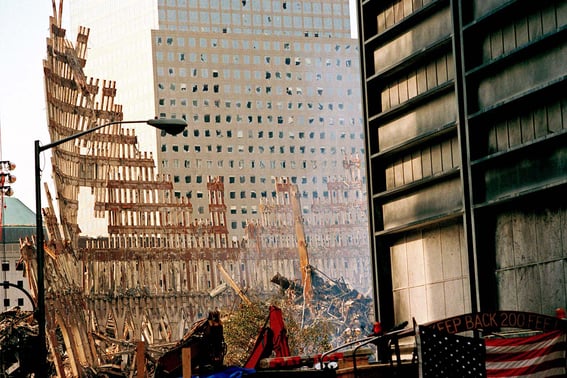
It was at that point that they realized that with the second building in imminent danger of collapse, they needed to vacate the area immediately. He made sure everyone was out of 7, and then started back for the command post for further instructions.
“I was maybe 200, 250 feet or so—maybe not even that much—from the middle of Vesey Street between the World Financial Center and the North Tower, when I heard that sound again. And I said, ‘Oh, [no], the building’s collapsing.’ I didn't know what the sound was the first time, but clearly I knew what it was this time. I turned and I started to run.”
Peruggia made it a short distance before a firefighter called out, “Chief, the building’s collapsing!” and threw him to the ground to take cover. Peruggia crawled under a fire truck.
“Seconds later, everything was black. All this dirt was forcing its way in. And then it was just eerily quiet. I thought to myself, I’m underneath the fire truck, and I might be buried under 100 stories of rubble. This might be it for me.”
He couldn’t grab his radio, and his speaker mic was full of debris. His thoughts turned to the safety of his family. All he could do was continue to try to move.
For fifteen minutes, he lay there, buried under the fire truck, trying to move his leg. A few firefighters and police officers saw him and were able to pull him out.
After cleaning up in the back of the fire engine and fighting off disorientation, Peruggia wondered whether to try to get down to the command post. “I saw one of the staff fire chiefs, who was the chief in charge of fire prevention at the time, and I went up to him and said, ‘Hey, I was buried under this truck after the collapse—you guys got me out. You know, the command post was there.’ He looked at me and said, ‘Kid, the command post is gone. They're all gone. It’s just me and you here, and we're gonna have to set up a command post.’”
They went to a nearby command vehicle, turned on the EMS radio frequency, and assumed command.
Pete Ganci, who had earlier expressed concern for Peruggia’s safety, was killed in the collapse of the second tower. That was the last exchange of words Peruggia had with him.
Peruggia spent the entire day believing that Richie, too, had been killed in the collapse, after he had sent him to deliver the message to Ganci.
At 21:12 in this Eyewitness News documentary, Richie (in blue) can be seen
delivering Chief Peruggia's message to Chief Ganci and Commissioner Feehan.
“I didn't see Richie again on September 11 until about 5:30 that night,” said Peruggia. “I thought he was dead, because I knew that the chief of the department was dead at that time. And I thought it was just a matter of time until they found Richie. And you know, I have to do my job…all the while thinking about that in the back of my head.”
“So when Richie showed up at the command post, I was yelling and cursing at him and punching him, like ‘Why didn’t you—?’ and he said, ‘I couldn't get through to you! I knew you were okay, because I heard you on the radio.’ I said ‘Yeah, and I thought you were dead, and I was terrified I was going to have to explain it to your wife!’
“So Rich had made it to the command post. And, as he got to the command post, Pete Ganci’s aid, who was a good friend of ours, said ‘Rich, what are you doing, what's the matter?’ and he goes, ‘I need to talk to the Chief, I’ve got an urgent message from John.’ They brought me right in, and I was standing there with Pete Ganci and Bill Feehan,’ who was the first deputy fire commissioner, ‘and we had our arms huddled together, and I was telling them your message, and then the building came down on us.’”
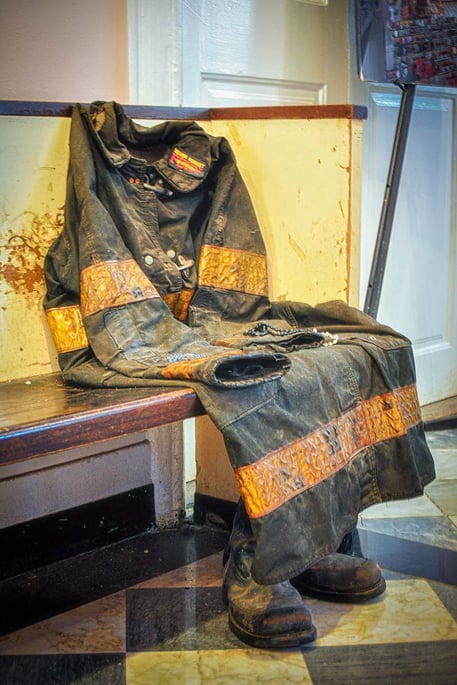
Thank you for joining us for Chief Peruggia's eyewitness account of 9/11. Read part 2 — Remembering 9/11: Picking up the Pieces and Shaping the Future.

December Recap After an incredibly busy events year with 102 conferences, trade shows, and sponsorships, December was on the slower side for us, with...

Editor's Note: In July 2025, EMS1 and Fitch & Associates released their annual EMS trend survey, What Paramedics Want, proudly sponsored by Pulsara....
![[PRESS RELEASE] Published Research Finds Up to 31% Faster STEMI Treatment Times in Rural Hospital Setting with Pulsara](https://www.pulsara.com/hubfs/_1_website-page-blog-assets/pulsara-hosp-teams-assign-cardio-stemi-rn-1200x701.jpg)
Published research shows how using Pulsara, alongside standardized field activation and a focus on stakeholder relationships, improves STEMI care and...